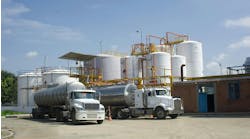Mack Trucks enhances MD Series with 23,000-lb. rear axle and 325 horsepower engine rating
To give Mack Trucks’ vocational customers improved durability and broader options for their applications, Mack now offers a 23,000-lb. rear axle and Cummins B6.7 engine with up to 325 horsepower on its Mack MD Series models.
Designed for a gross axle weight rating of up to 23,000 lb., the heavier axle and suspension offer increased capability for hauling loads requiring the most durable of trucks. The Mack MD with the 23,000-lb. rear axle benefits refuse packers with 11-yard up to 20-yard rear loaders, as well as those Mack MD models being used as water trucks holding 2,000 to 2,500 gallons of water.
When paired with the 325 horsepower engine rating and the Allison 3000RDS transmission, the Mack MD is now capable of increased towing capacity if the customer has a trailer.
“The 23,000-lb. rear axle expands the applications in the vocational market—with refuse and construction reaping the most benefits,” Tim Wrinkle, Mack VP of vocational and medium duty, said. “The 325 horsepower also offers carriers traversing longer routes or in a hilly or mountainous region a more durable and reliable powertrain. The rear axles on those truck models equipped with a dump body, hook lift, or roll-offs take some abuse during the truck’s lifespan. The heavier axle rating has better durability, and the larger horsepower engine will provide enhanced performance.”
See also: Shop owner brings precision-based advancement to industry
The Mack MD6, a Class 6 model, has a gross vehicle weight rating of 25,995 lb. and the MD7, a Class 7 model, has a GVWR of 33,000 lb. Both models are exempt from the 12% Federal Excise Tax.
The Mack MD Series models meet the needs of trucking applications requiring dry van/refrigerated, stake/flatbed, dump, and tank truck vocations. The MD6 model does not require a CDL to operate for non-hazardous payloads.
Available in 4x2 configurations, the MD6 and MD7 models feature a sharp wheel cut for enhanced maneuverability in tough urban settings. The MD Series cab was updated in January to a larger cab with bumper-to-back-of-cab measurement of 107 inches. Mack matched the bold look and styling of the Mack Anthem as a basis for the grille and hood design found on the MD Series.
The interior boasts satin aluminum trim, improved seating with lumbar support, and enhanced LED lighting. New steering wheel controls for cruise control, phone, and audio functions have been added. The trucks now come standard with several enhanced safety features, including new ABS with ATC, radio mute in reverse, and a park brake alarm.




